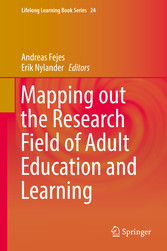
Mapping out the Research Field of Adult Education and Learning
von: Andreas Fejes, Erik Nylander
Springer-Verlag, 2019
ISBN: 9783030109462
Sprache: Englisch
228 Seiten, Download: 6881 KB
Format: PDF, auch als Online-Lesen
| Series Editors’ Note | 6 | ||
| Contents | 8 | ||
| Part I: Introducing and Historicizing the Field | 10 | ||
| Chapter 1: Introduction: Mapping the Research Field on Adult Education and Learning | 11 | ||
| 1.1 Introduction | 11 | ||
| 1.2 A Brief History of Adult Education Research | 12 | ||
| 1.3 A Qualitative and Heterodox Turn | 14 | ||
| 1.4 Introducing the Chapters | 16 | ||
| References | 20 | ||
| Chapter 2: Examining the “Weak Field” of Adult Education | 22 | ||
| 2.1 Introduction | 22 | ||
| 2.2 The Social World of Adult Education Research | 24 | ||
| 2.3 The Scientific Field of Adult Education | 26 | ||
| 2.4 Previous Findings Regarding Adult Education as a Scientific Field | 27 | ||
| 2.5 Discussion | 31 | ||
| 2.5.1 Regional Fragmentation of the Field | 31 | ||
| 2.5.2 Hollowing Out of the Field | 32 | ||
| 2.5.3 Relevance Deficit | 33 | ||
| 2.6 Concluding Note | 34 | ||
| References | 35 | ||
| Chapter 3: Adult Education Research in Germany: Approaches and Developments | 39 | ||
| 3.1 Introduction | 39 | ||
| 3.2 Adult Education Research in Germany: Theoretical Frameworks | 40 | ||
| 3.3 ‘Learning’ or ‘Bildung?’ The Aims of Adult Education | 43 | ||
| 3.4 Adult Education Research: A Short Historical Overview | 44 | ||
| 3.4.1 The Beginnings: 1900–1933 | 45 | ||
| 3.4.2 Adult Education Research in the Federal Republic of Germany 1949–2000 | 46 | ||
| 3.4.3 The Role of the Scientific Community | 48 | ||
| 3.5 Trends and Topics in Adult Education Research Since 2000 | 50 | ||
| 3.5.1 Topics of Adult Education Research | 50 | ||
| 3.6 Discussion | 52 | ||
| References | 56 | ||
| Part II: Invisible Colleges and International Recognition | 58 | ||
| Chapter 4: Exploring the Adult Learning Research Field by Analysing Who Cites Whom | 59 | ||
| 4.1 Introduction | 59 | ||
| 4.2 Governed by Peers | 61 | ||
| 4.3 Previous Research | 62 | ||
| 4.4 To Understand Research Through Citations: Theory and Method | 63 | ||
| 4.4.1 Method, Data and Analysis | 64 | ||
| 4.5 The Space of Citations: A Telescopic and Bibliographic View | 67 | ||
| 4.6 Moving Across the Field | 70 | ||
| 4.7 Concluding Remarks: A Bibliographic Field Analysis of Research on Adult Learning | 71 | ||
| 4.7.1 Some Notes on Bibliometrics and Suggestions for Future Research | 74 | ||
| References | 75 | ||
| Chapter 5: Invisible Colleges in Research on Adult Learning: A Bibliometric Study on International Scholarly Recognition | 77 | ||
| 5.1 Introduction | 77 | ||
| 5.2 Invisible Colleges | 79 | ||
| 5.3 The Study: Invisible Colleges in Research on Adult Learning | 82 | ||
| 5.4 The Top 100 Cited Authors | 83 | ||
| 5.4.1 The Dominant Duo: UK and US | 86 | ||
| 5.4.2 The Male Domination | 87 | ||
| 5.5 The Journal-Specific Citation Networks | 88 | ||
| 5.6 Discussion | 94 | ||
| 5.6.1 The Academic Power of Editors | 97 | ||
| 5.6.2 The Research Field(s) | 98 | ||
| References | 99 | ||
| Chapter 6: The Politics of Publications and Citations: A Cross Country Comparison | 102 | ||
| 6.1 Introduction | 102 | ||
| 6.2 Methodology, Data, and Analysis | 104 | ||
| 6.2.1 Limitations of the Study | 105 | ||
| 6.3 Result | 106 | ||
| 6.3.1 The Politics of Indexation | 106 | ||
| 6.3.2 Politics of Scholarly Gatekeeping | 108 | ||
| 6.3.3 Politics of Publication and Citations | 110 | ||
| 6.4 Discussion | 113 | ||
| 6.5 Conclusions | 115 | ||
| References | 117 | ||
| Part III: Research Approaches and Research Objects | 119 | ||
| Chapter 7: Adult Education and Learning: A Pluralistic Research Field? | 120 | ||
| 7.1 Introduction | 120 | ||
| 7.2 Categories and Principle of Classification | 122 | ||
| 7.3 Findings: Content Analysis and Bibliographics Based on Citations | 123 | ||
| 7.4 Authorship | 126 | ||
| 7.5 Bibliometric Trends in the Field of Adult Education Research | 129 | ||
| 7.5.1 A Qualitative Research Paradigm | 129 | ||
| 7.5.2 Three Theoretical Perspectives | 131 | ||
| 7.5.3 Authorship | 133 | ||
| 7.6 Concluding Notes | 135 | ||
| References | 136 | ||
| Chapter 8: Quantitative Research in Research on the Education and Learning of Adults | 139 | ||
| 8.1 Introduction | 139 | ||
| 8.2 Hypotheses on the Limited Presence of Quantitative Research in the Adult Education Literature | 140 | ||
| 8.3 Research Paradigms | 141 | ||
| 8.4 Review Procedure Distinguishing Between Quantitative and Qualitative Approaches | 142 | ||
| 8.5 Results | 143 | ||
| 8.5.1 General Patterns | 143 | ||
| 8.5.2 Primary Data in Quantitative Research | 144 | ||
| 8.5.2.1 Participation Scales | 145 | ||
| 8.5.2.2 Scales Measuring Learning Experiences | 147 | ||
| 8.5.2.3 Psychometric Scales | 147 | ||
| 8.5.2.4 Scales Measuring Learning Styles | 148 | ||
| 8.5.3 Secondary Data in Quantitative Research | 149 | ||
| 8.6 Limitations, Discussion and Conclusions | 151 | ||
| References | 153 | ||
| Chapter 9: Adult Education Research from Rhizome to Field? A Bibliometrical Analysis of Conference Programs of ESREA from 1994 to 2016 | 156 | ||
| 9.1 Mapping Adult Education Research | 156 | ||
| 9.2 Data and the Method ‘Program Analysis’ | 158 | ||
| 9.2.1 Data: Papers of ESREA Triennial Research Conferences | 158 | ||
| 9.2.2 The Method Applied: Program Analysis | 160 | ||
| 9.3 Results of the Analysis | 161 | ||
| 9.3.1 The Role of Conference Sites | 161 | ||
| 9.3.2 The Role of Countries and Supranational/International Organisations | 162 | ||
| 9.3.3 The Most Visible Scholars | 166 | ||
| 9.3.4 The Methods and the Fields of Research | 168 | ||
| 9.4 Discussion of Results | 170 | ||
| 9.4.1 Places Matter Immediately But Briefly | 170 | ||
| 9.4.2 The Still Fragmented European Research Rhizome of ESREA | 170 | ||
| 9.4.3 The International Actors and Policies Become More Influential in the Field | 171 | ||
| 9.4.4 Citing Adult Education Researchers and Scholars Like Bourdieu and Foucault | 171 | ||
| 9.4.5 Preferred Approach and Method of the Field: Interviewing Learners | 172 | ||
| 9.5 Concluding Remarks: Research in ESREA Between Field and Rhizome | 173 | ||
| References | 174 | ||
| Part IV: Debating International Comparative Adult Education Research | 177 | ||
| Chapter 10: Revisiting the Debate on International Comparative Adult Education Research: Theoretical and Methodological Reflections | 178 | ||
| 10.1 Introduction | 178 | ||
| 10.2 Jullien de Paris as an Ancestor of International Comparative Adult Education Research | 180 | ||
| 10.3 The Pre-foundation or ‘Bridging’ Period 1900–1930 | 182 | ||
| 10.4 The Foundation Period After World War II | 187 | ||
| 10.5 The Phase of Institutionalisation | 189 | ||
| 10.6 Comparison as an Instrument of Governance | 191 | ||
| 10.7 Discussion | 195 | ||
| References | 197 | ||
| Chapter 11: Debating (International) Comparative Adult Education Research: Reflections on Conceptual Clarity and Methodological Challenges | 200 | ||
| 11.1 Introduction | 200 | ||
| 11.2 Adopting a Comparative Mind-Set to Researching Adult Education | 201 | ||
| 11.2.1 Conceptual Degreeism and a Qualifier’s Intrinsic Features but Nonunanimous Interpretation | 202 | ||
| 11.2.2 Flacking vs. Connecting Qualifiers, and Internal Conceptual Coherence | 204 | ||
| 11.3 Global and Comparative Adult Education Research on Policy | 206 | ||
| 11.4 The Challenges of Comparative Adult Education Research on Policy Through Country Comparisons | 209 | ||
| 11.4.1 The Researcher’s Positioning | 210 | ||
| 11.4.2 Validating the Selection of Countries | 211 | ||
| 11.4.3 Comparing Country- and Cultural-Sensitive Units of Analysis | 213 | ||
| 11.5 Concluding Remarks | 214 | ||
| References | 216 | ||
| Chapter 12: A Rejoinder on the Debate on International Comparative Adult Education Research | 219 | ||
| References | 221 | ||
| Part V: Looking Ahead | 222 | ||
| Chapter 13: The Research Field of Adult Education and Learning: Widening the Field | 223 | ||
| 13.1 Introduction | 223 | ||
| 13.2 Mapping Out the Field | 225 | ||
| 13.3 Widening the Field | 226 | ||
| 13.4 Final Words | 228 | ||
| References | 228 |








